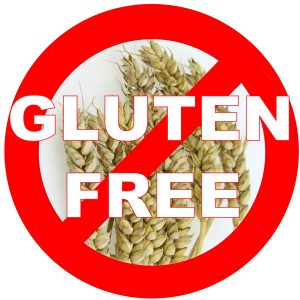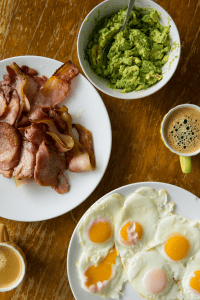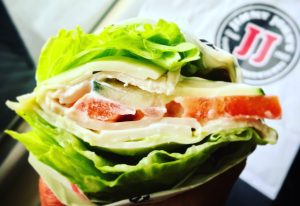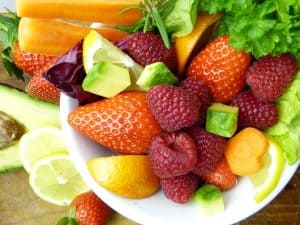It seems like everywhere you turn nowadays, a new diet has popped up. You know, Keto vs Paleo vs Atkins, and so on and so on. As it turns out, these diets have been around for quite some time. In fact, Atkins has been around since the late 1980s. Keto was created in the early 1900s. And Paleo– well, that’s been around for millions of years.
(That was a joke, by the way.)
Kind of like fashion, these diets keep coming back into popular culture. Furthermore, everyone tends to believe that their diet is the only diet that works. The truth is that every diet has its positives and negatives. Some diets just work better for certain people.
Likewise, many aspects of these diets overlap, so the lines can blur. In this post, we’re going to demystify it all and compare Keto vs Paleo vs Atkins.
Note: The keto diet is very similar to Atkins, though there are several differences. We’ve already written a detailed post about the Keto Diet vs Atkins Diet. Feel free to click for a more in-depth comparison of those two diets.
Keto vs Paleo vs Atkins: The Differences
#1: Keto and Atkins are Low Carb diets; Paleo doesn’t have to be

Keto and Atkins are both low carb diets, while the Paleo diet is not necessarily one. We say “not necessarily” here because you certainly can eat a low carb Paleo diet. However, “low carb” is not one of the tenets of Paleo.
While keto and Atkins both extol the benefits of a low-carbohydrate diet, the requirements are not exactly the same. The keto camp generally recommends only eating 20g net carbs daily. Similarly, the Atkins folks start with around 20g net carbs daily– but an increase is allowed in a phased approach.
Keto vs Paleo vs Atkins – Takeaway about Carbohydrate Intake:
Keto and Atkins are both low carb diets that suggest the intake of around 20g net carbs daily.
However, you are allowed to gradually increase your carbohydrate intake on Atkins, unlike on keto.
Paleo does not provide guidelines for carbohydrate intake.
#2: Paleo is a whole, natural diet; Keto and Atkins don’t have to be

Keto and Atkins are not necessarily natural foods diets. You can find many keto and Atkins-friendly foods and products that are highly processed. Even so, there are plenty of natural, whole foods that are acceptable on keto and Atkins diets.
Paleo foods must not only be natural, on the other hand, must adhere to strict guidelines.
Let’s take this time to dig into the history and rationale behind each of the three diets.
The basis of each of the diets in a nutshell:
-
Paleo
- Research from the 1990s into Paleolithic eating habits led scientists to believe that eating and living like our ancestors would cure most modern maladies. This includes issues like obesity and metabolic diseases like diabetes.
- There weren’t many dietary guidelines prescribed by the scientists. They strongly believed that dairy and grains were not a part of a Paleolithic diet. Instead, our predecessors ate mostly foraged fruit and parts from whole animals.
-
Keto
- The ketogenic diet was originally created in the early 1900s. It was found that when the body was a state of ketosis, epileptic seizures were drastically reduced in children.
- A positive side effect of this was that body fat was converted to ketones during ketosis, resulting in weight loss.
- By severely restricting carbohydrates and increasing fat intake, you coax your body into a state of ketosis. In this state, your body converts fat into fuel (ketones). Fat conversion to ketones provides more sustained energy and less blood sugar fluctuations.
- Additionally, the increased fat intake, either via foods or supplementation, should lead to greater satiety.
-
Atkins
- Like the keto diet, Atkins calls for a very low carbohydrate intake during an initial two-week phase.
- However, the thought is that this extremely low carbohydrate intake is not sustainable over the long term.
- As such, Atkins calls for a gradual increase of carbohydrate intake, 5g net carbs at a time. You continue this increase until you no longer lose weight, but rather maintain it.
Keto vs Paleo vs Atkins – Takeaway about History and Rationale:
Modern variations of all three diets all were formed from scientific inquiries into dietary needs.
The Paleo diet is the only diet out of the three that strictly calls for natural, minimally processed foods.
#3: Paleo food products can receive official certification. There are no certifying authorities for keto or Atkins.
Paleo certification is pretty strict! Here are the requirements:
Paleo-certified foods must be:
- Grain-Free
- Legume-Free
- Dairy-Free
- Contain no artificial coloring, preservatives, artificial sweeteners, or flavor enhancers
Keto and Atkins do not restrict any of the above criteria outright. For instance, you could eat one grain of rice, one bean, take a sip of milk and drink some Diet Coke and be fine on keto and Atkins. But, in the Paleo world, that would essentially be akin to murder.
Keto vs Paleo vs Atkins – Takeaway about Certification Standards:
Paleo certification includes a strict set of guidelines on approved ingredients. We believe that these guidelines have great intentions. It’s a bonus for those on Atkins or keto to try to apply these principles to their diets wherever possible.
There is no certifying authority for keto or Atkins. However, note that Atkins is itself is a company (Atkins Nutritionals, Inc.). Anything you see labeled with the Atkins brand comes from the company and comes with their “approval.”
#4: Foods in all 3 diets are predominantly grain- and gluten-free. The diets differ mainly in the categories of dairy and artificial ingredients.

Quick side note: Gluten is a protein that is found in grains. Therefore, when a food is grain-free, it’s also gluten-free by association.
You’ll find that most foods that are touted as keto and Atkins friendly end up being grain-free (e.g., butter, red meat, almond flour). It just so happens that grains are carb-heavy. Therefore, if you remove grains from the equation, you end up with low carb foods that are great for keto and Atkins.
With that said, you’ll find that foods that are friendly to the keto and Atkins diets will also hit the marks for grain-free and legume-free. This is because foods like wheat and beans tend to be higher in carbs anyway and you would generally avoid them on low carb diets.
The difference is dairy and artificial ingredients
The big categories where Atkins and keto will differ from Paleo are dairy and artificial ingredients. Foods like cheese, butter, and heavy cream are highly prevalent in the low carb and keto worlds. The Paleo diet strictly prohibits them.
Likewise, you’ll find artificial sweeteners abound in low carb foods. These are fine for keto and Atkins, but are a big no-no for Paleo.
Keto vs Paleo vs Atkins – Takeaway about the differences in food types:
All three diets are generally grain and gluten-free, but Paleo must be grain-free.
Dairy is forbidden on Paleo, but is usually used heavily in the keto and Atkins diets.
There are no restrictions on artificial ingredients for the keto and Atkins diets as long as they are not high in carbohydrate content.
#5: The Fat Factor

You’ll notice that the types of fat and meats allowed on the Paleo diet end up overlapping with common foods you’ll see on keto. Eggs, bacon, ghee, coconut oil are all Paleo-friendly. At the same time, you might see a keto dieter chowing down on the same thing. An animal-based Paleo diet will see a definite increase in fat, mainly from meat and nuts.
Oil Source
The big difference is that Paleo diets shun the use of processed vegetable oils, which are high in polyunsaturated fatty acids (PUFAs). These PUFAs are thought to cause inflammation and promote disease in the body. Atkins and keto do not restrict the type of oils that you can eat.
It’s a slight distinction, but here’s an example: A chicken wing fried in vegetable oil would not be allowed on Paleo. But if it were fried in lard or tallow, it would be allowed. Either method would be acceptable on keto or Atkins.
One more thing: Atkins is not a high-fat diet. Unlike Paleo and keto, Atkins has a fat recommendation of 35g-40g per day during all its phases. Keto is definitely a high-fat diet and Paleo doesn’t provide fat guidelines.
Keto vs Paleo vs Atkins – Takeaway about Fat Intake:
Both the Paleo and keto diets allow for high fat intake. Atkins, however, provides a fat intake recommendation of approximately 40g of fat per day, regardless of carbohydrate intake. Keto and Atkins don’t restrict the source of your fats, while Paleo restricts them to natural sources, like nuts and meat.
#6 The Major Difference is the Carbohydrate Intake (and mainly sugar)

So while fat and protein intake is very similar between Keto vs Paleo vs Atkins, carbohydrates are the real difference. The biggest culprit is probably sugar.
Keto and Atkins advocates stress the fact that sugar increases the release of insulin in the body, which promotes the conversion of carbs to fat in the body. Over time, this may lead to insulin resistance in the body, and many believe this resistance is the root of metabolic diseases. Since there is no strict guideline for sugar intake on Paleo, the following extreme example might apply:
A cake made from almond flour and sweetened with 100g of sugar from coconut sugar would be fine for Paleo, but unacceptable on keto or Atkins. But if erythritol was the main sweetener, that cake would perfectly acceptable on keto or Atkins.
What about whole foods?
Whole foods can be just as perplexing. In moderation, you can eat some fruit on the keto diet, such as blueberries and strawberries. However, starchier fruits like bananas are too high in carbohydrates for keto, but completely fine for Paleo.
One last note about Paleo-friendly sweeteners:
Honey, maple syrup, and coconut sugar are ubiquitous in Paleo-friendly sweets. However, other non-artificial sweeteners, such as stevia, monk fruit extract, and birch tree xylitol– all of which are zero carb sweeteners– are actually allowed on Paleo.
We are not entirely sure why more manufacturers do not utilize these approved sweeteners. Perhaps ingredient cost and consumers’ taste preferences are factors. These alternative sweeteners would cut down the carb content of many Paleo foods.
But, what that means for those on Paleo who are also trying to stay low carb, is you can absolutely look for food products that use these Paleo-approved sugar alternatives.
Keto vs Paleo vs Atkins – Takeaway about Carb Intake:
Both the keto and Atkins diets have guidelines surrounding carbohydrate intake and generally recommend 20g net carbs per day.
There are no carbohydrate intake guidelines for the Paleo diet– you can eat a low carb or high carb Paleo diet.
Wrapping it up
Okay, that was a lot to digest, right? (Pun intended). Let’s wrap things up.

There’s a place where all three diets can co-exist.
If you were looking at a Venn Diagram for keto vs Paleo vs Atkins, there is a place where all three can peacefully co-exist! In this space, foods must be naturally-sourced to fit within Paleo guidelines. So that means grain-free, legume-free, dairy-free and free from artificial additives.
If you then restrict your carbohydrate intake to 20g per day, you’d be Paleo-friendly, keto-friendly and fit into the initial phase of the Atkins diet (as long as your fat intake was moderate).
Take it Slow
If you’re just starting your low carb diet journey, combining Paleo and low carb might just be too restrictive. In that case, we’d suggest you begin with low carb and once you are more comfortable, make modifications to make move towards more Paleo-centric foods.
Keto vs Paleo vs Atkins: Who’s it for?
- You might like Paleo if you don’t want to restrict how many carbs you eat.
- If you’re in this camp, we strongly urge that you avoid added sugar. That includes things like honey, coconut sugar, fruit juices and maple syrup.
- Instead, aim for whole fruits for your sugar and primarily “foraged fruits” like berries. And remember, you have Paleo-approved alternative sweeteners like Stevia available to you.
- As for the rest of the carbs, the grain and legume restrictions of Paleo should keep your carb intake relatively moderate.
- You might like keto if you enjoy eating high-fat foods and can restrict your carbs.
- If you love high-fat foods, the increased fat should help you sustain low carb eating long-term.
- This can keep you at an ideal body weight, but also provide you with consistent energy levels.
- Being fat-adapted on keto can also benefit physical activities like endurance training.
- You might like Atkins if you can’t sustain or don’t want to eat ultra low carb forever.
- Unlike with keto, after you’ve reached your weight loss goals, Atkins then directs you to increase your intake of carbs slowly until your weight stabilizes.
- If this allows you to stay on a low to moderate carb diet long-term, the Atkins approach may be right for you.
Our Take on Keto vs Paleo vs Atkins
We believe the best mix of the diets would be a low-carb variation of the Paleo diet.
Going too wild with Paleo-friendly ingredients
Our concern with the modern Paleo diet lies in the fact that you can get very creative with Paleo ingredients. It’s likely that a caveman would not have eaten many of the Paleo certified foods of today. For example, Paleolithic people were likely not harvesting yucca and processing it into tapioca starch to fry in coconut oil.
Likewise, one can use honey gratuitously on the Paleo diet, but it’s unlikely that honey was a staple in our ancestors’ diets.
That’s not a knock against the Paleo diet. It’s likely the intention behind the scientific research that led to the Paleo diet may have been lost by our modern society. Many manufacturers take Paleo-friendly ingredients and process them into modern foods and snacks. Look, that’s great, and we definitely appreciate the convenience of and rely on these food options. But at the same time, we also monitor and regulate our carbohydrate intake.
Availability of Fruit in the Modern Age
Another issue is that fruit is much more widely available in present times than it was in the past. In fact, you can find many fruits year-round that you normally wouldn’t be able to without the growth of international commerce. These types of things definitely factor into the increased levels of carbohydrate intake in Western society.

Closing Note
We believe a Paleo-centric diet with a carbohydrate restriction would be ideal. You gain the benefits of eating natural, wholesome foods combined with a lower risk of disease due to excessive carbohydrate consumption. In our opinion, this likely mimics the diet of the distant past more closely. Living conditions and food availability probably would have naturally moderated carbohydrate consumption in humans.
Still, diet is just one small part of the holistic lifestyle of humans. Diet in and of itself isn’t likely going to be a panacea for modern illness. We believe that eating more naturally, lowering your carbohydrate intake, living a more active lifestyle, and reducing stress all are great steps toward bettering your overall health.



[…] Best Paleo Diet Versus Atkins from Keto vs Paleo vs Atkins What s best for you Convenient. Source Image: convenientketo.net. Visit this site for details: convenientketo.net […]
Thankyou for this wondrous post, I am glad I found this site on yahoo.
This really answered my problem, thank you!
Hello, Neat post. There is an issue along with your website in web explorer, would test this?K IE nonetheless is the marketplace chief and a big component of folks will pass over your magnificent writing due to this problem.